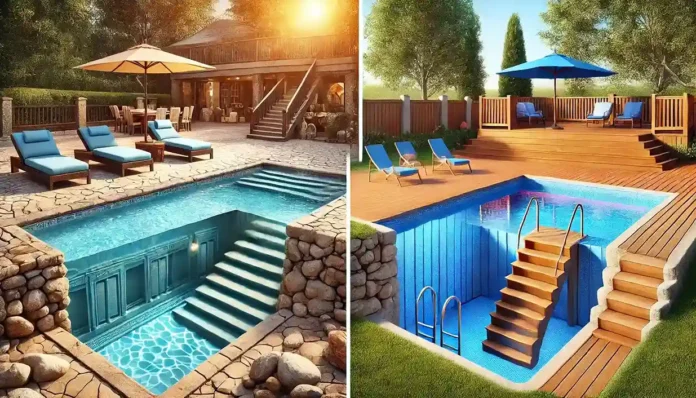When considering adding a pool to your backyard, one of the first decisions you’ll face is whether to opt for an inground or above ground pool. Both options offer unique benefits, but the most significant difference between them often comes down to cost. For many homeowners, the price tag plays a major role in the final decision. In this article, we’ll break down the costs of each type of pool and help you weigh the pros and cons of inground and above ground pools to make the best choice for your budget and lifestyle.
Initial Costs: A Big Difference
The most obvious difference when comparing inground and above ground pools is the initial installation cost. Above ground pools tend to be far more budget-friendly upfront. Depending on the size and features, you can expect to pay anywhere from $1,500 to $5,000 for an above ground pool, including installation. These pools are typically quicker to install and require less labor, contributing to their lower cost.
In contrast, inground pool prices are a bigger investment, with prices starting around $25,000 and easily climbing to $50,000 or more. Factors such as pool size, shape, material (concrete, fiberglass, or vinyl), and additional features like landscaping or custom designs all influence the total cost. While inground pools are built to last and offer more design flexibility, the higher cost of installation is one of the major deterrents for homeowners on a budget.
Long-Term Maintenance Costs
The initial cost is just the beginning; maintenance is another key factor to consider. In general, inground pools require more maintenance than above ground pools. This is due to the larger size, more complex filtration systems, and higher level of customization that come with inground pools. You’ll need to budget for chemicals, regular cleaning, and occasional repairs. The yearly maintenance costs for an inground pool can range from $1,000 to $2,000, depending on the size and condition of the pool.
On the other hand, above ground pools typically have lower maintenance costs. Since they’re smaller and easier to manage, the maintenance tasks (such as cleaning, chemical balancing, and covering during winter months) tend to be less expensive. You might spend $500 to $1,000 annually on maintenance for an above ground pool, making it a more affordable long-term choice.
Durability and Lifespan
When it comes to durability, inground pools generally have the upper hand. These pools are built to last for decades and can withstand various weather conditions. With proper care, an inground pool can easily last 30 years or more. The materials used in construction, such as concrete, fiberglass, or vinyl, contribute to their longevity.
Above ground pools, however, are not as durable. Most above ground pools are made of metal, vinyl, or resin, which can degrade over time, especially if exposed to harsh weather conditions. While these pools typically last between 10 and 15 years, their lifespan is shorter than that of inground pools. That said, the lower upfront cost and less expensive maintenance may make this trade-off worthwhile for many homeowners.
Property Value Impact
Another consideration is how each type of pool affects your home’s resale value. Inground pools tend to have a more significant impact on property value, as they are considered a permanent and luxurious feature. However, it’s important to note that the added value might not always offset the initial cost, especially in markets where pools are not as desirable.
Above ground pools, while offering a more affordable alternative, generally don’t add as much value to your property. They are often seen as temporary or less luxurious than their inground counterparts, which can impact potential buyers’ perceptions. Still, an above ground pool can still be a good investment if you’re looking for enjoyment over the long term without the hefty price tag.
Flexibility and Aesthetic Appeal
Inground pools provide far more flexibility in terms of customization. Whether you envision a sleek, modern design or a more natural, lagoon-style pool, the options are endless. You can also incorporate additional features like waterfalls, fountains, and custom lighting, all of which elevate the pool’s aesthetics and ambiance.
Above ground pools, while available in various shapes and sizes, have more limited design options. However, they do come in various styles that can still complement your backyard’s aesthetic. Many homeowners choose to enhance the look of their above ground pool by adding landscaping or deck installations, creating a more polished look.
Installation Time
If you’re eager to enjoy your pool as soon as possible, an above ground pool is the faster option. Since these pools don’t require extensive excavation or customization, installation can typically be completed in a matter of days. This is particularly appealing for those who want to quickly set up a pool for the summer months.
Inground pools take much longer to install. The process can take several weeks or even months, depending on the complexity of the design and site conditions. During this time, you’ll need to plan around construction schedules and potential weather delays.
Which is the Better Option for You?
In the end, the choice between an inground and an above ground pool depends largely on your budget, long-term plans, and lifestyle preferences. If you’re looking for a more affordable, temporary pool with lower maintenance costs and faster installation, an above ground pool is a great option. On the other hand, if you’re willing to invest more upfront for a lasting, high-end pool that will increase your property value and offer greater customization, an inground pool may be the better choice.
Ultimately, both inground and above ground pools can provide countless hours of enjoyment, so it’s important to consider the pros and cons carefully before making your decision.



































